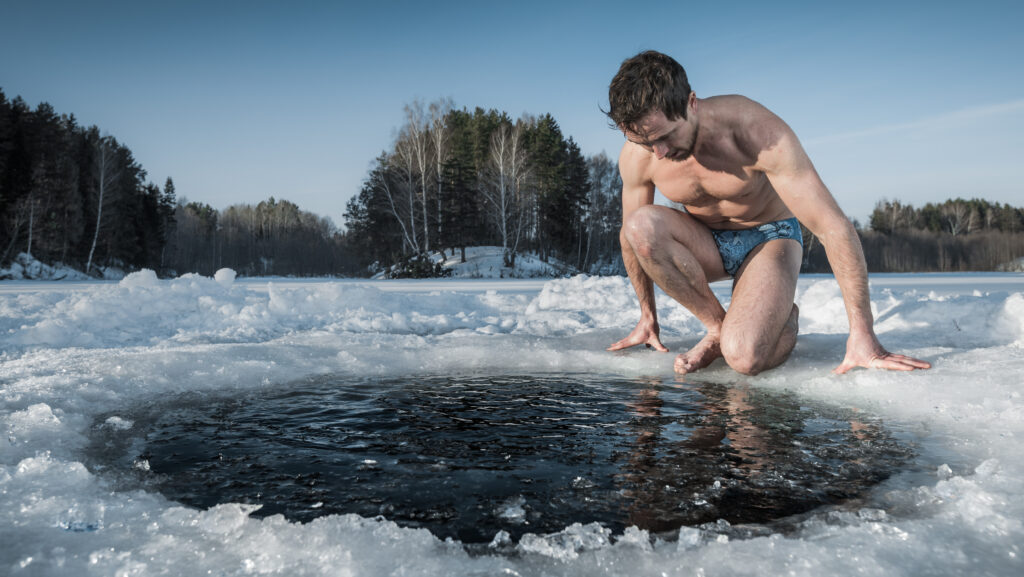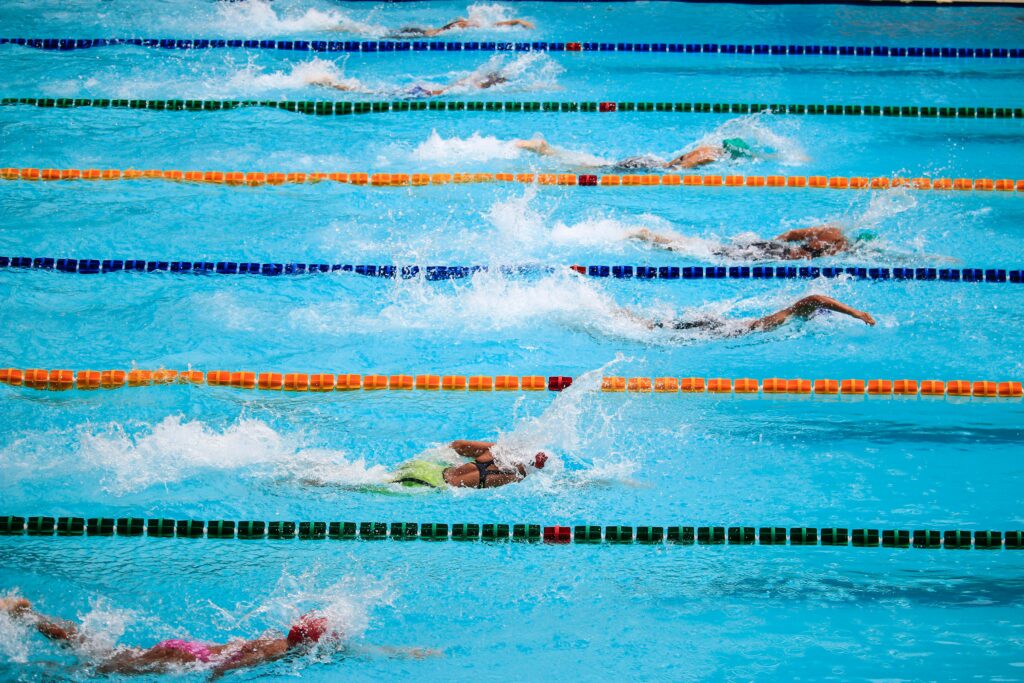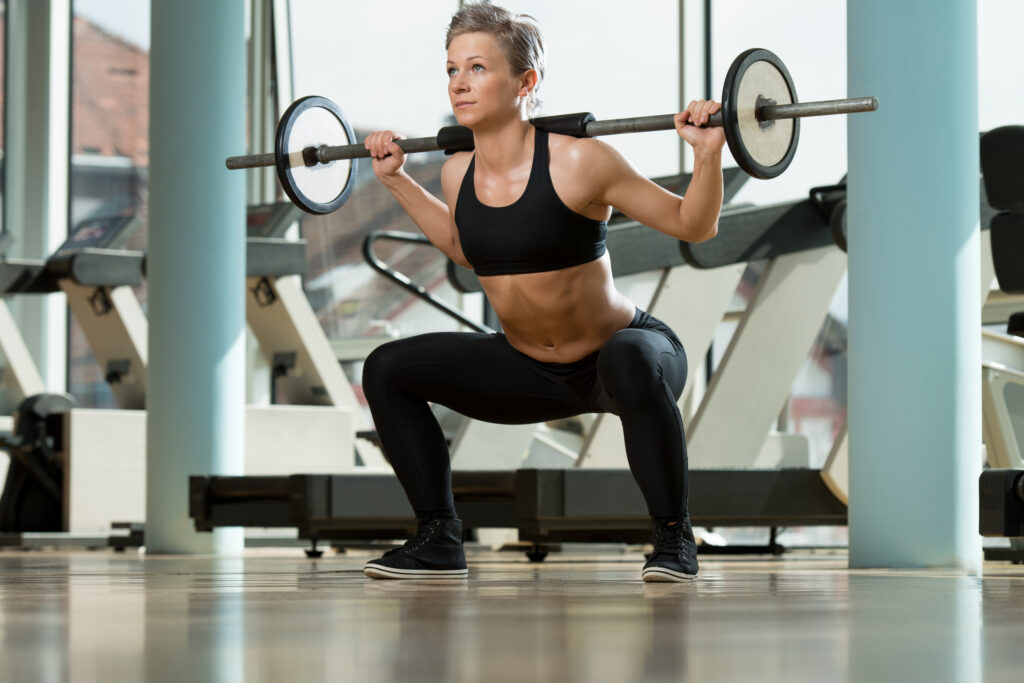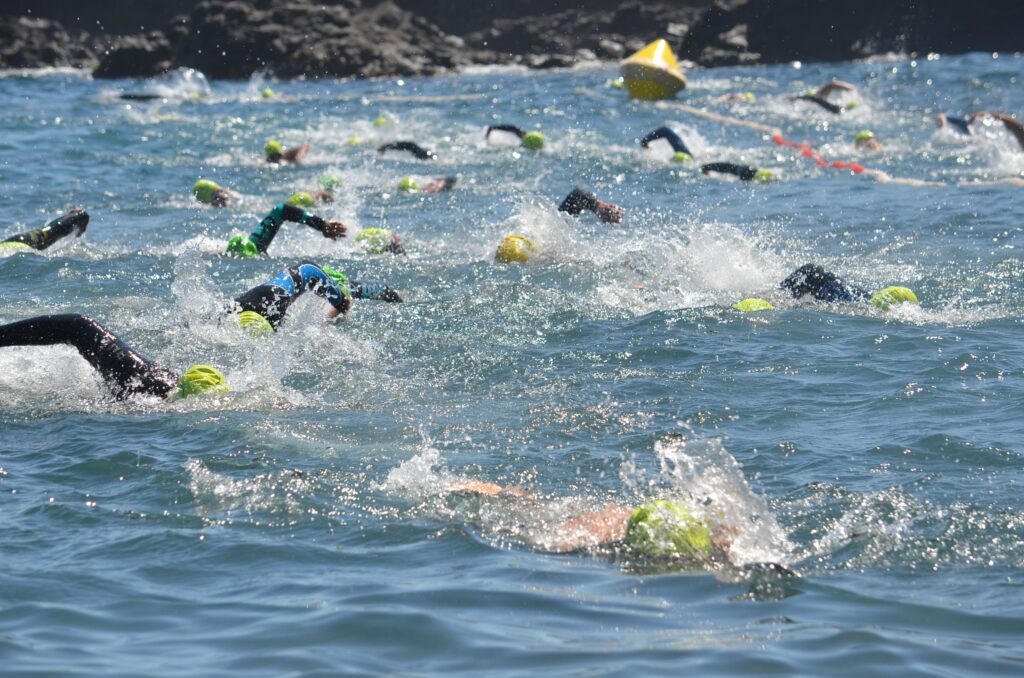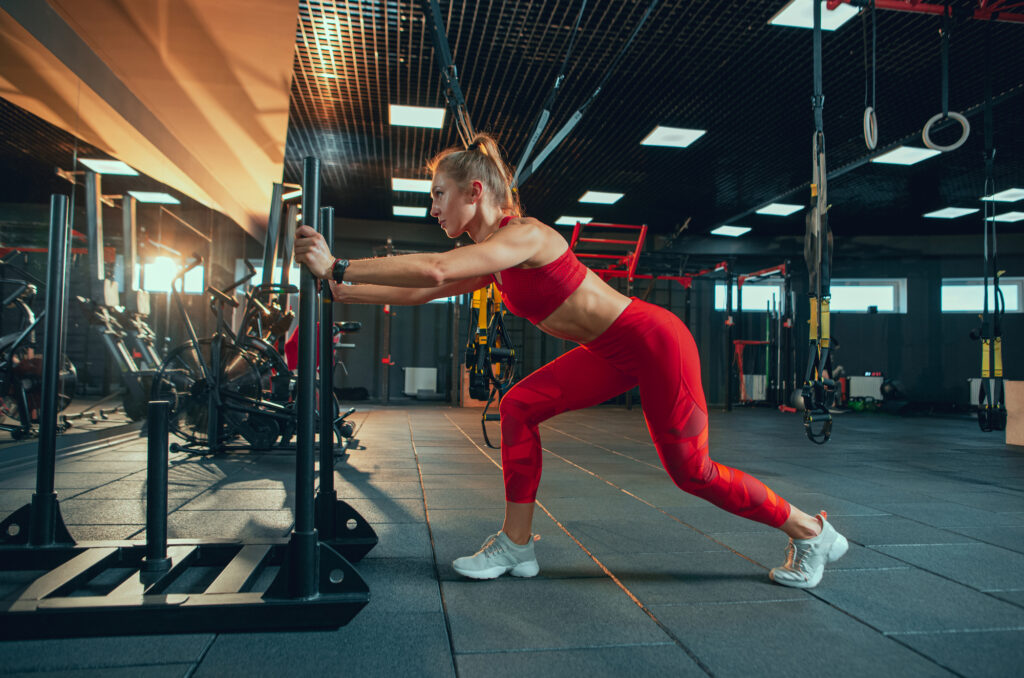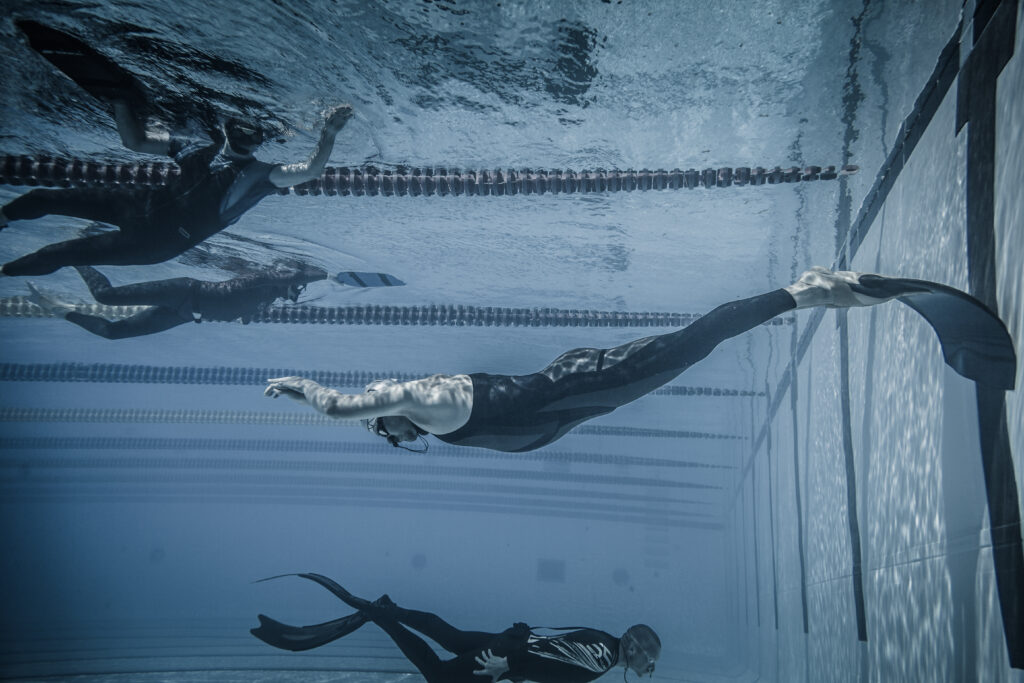Swimming backstroke engages a wide range of muscles throughout your body, making it an excellent full-body workout in the water. The main muscle groups used during backstroke swimming include the latissimus dorsi (lats), deltoids, trapezius, pectorals, core muscles, glutes and quadriceps. Each of these muscle groups plays a crucial role in propelling your body efficiently through the water while maintaining proper form and alignment.
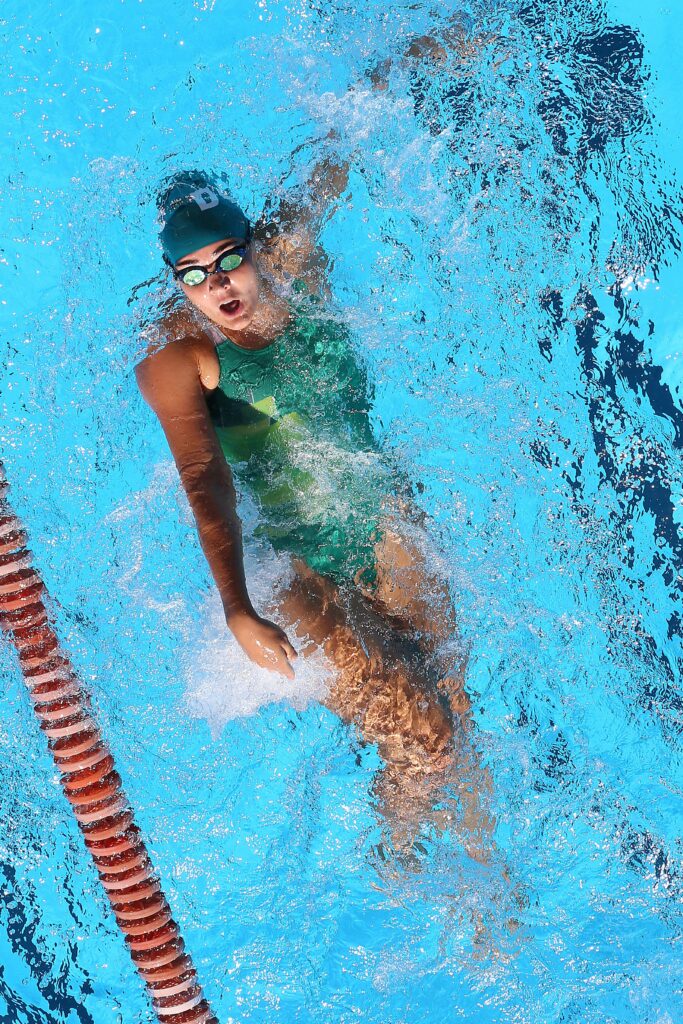
Unlike other swimming strokes, backstroke places unique demands on your body due to its face-up position. Your back and shoulder muscles develop greater mobility and range of motion while your core remains constantly engaged to maintain stability. The alternating arm movements heavily rely on your upper body strength, whilst the flutter kick activates your lower body muscles to provide additional propulsion.
Key Takeaways
- Backstroke primarily works the latissimus dorsi, deltoids and pectoral muscles in the upper body whilst engaging the core for stability.
- The flutter kick in backstroke activates the quadriceps, hamstrings and glutes, making it a comprehensive lower body workout.
- Proper backstroke technique ensures balanced muscle development across both sides of the body and improves overall swimming performance.
Overview of Backstroke Swimming Technique
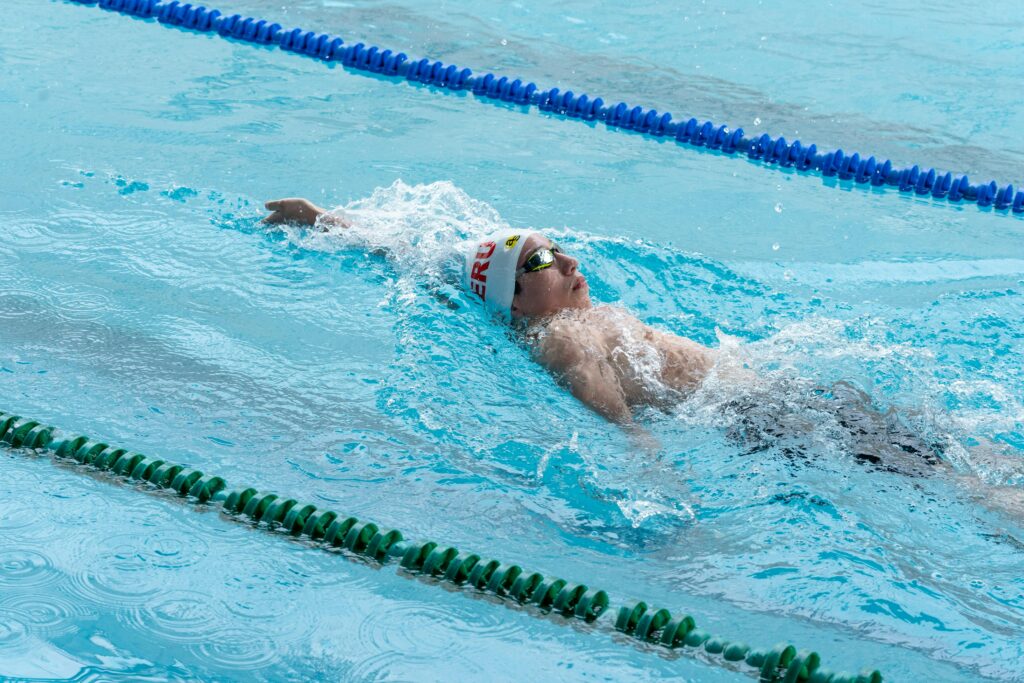
Backstroke is a unique swimming style that requires swimmers to float on their backs while propelling themselves through the water. This technique engages multiple muscle groups and demands precise coordination for efficient movement.
Key Mechanics of Backstroke
The backstroke begins with the swimmer lying flat on their back, arms extended above the head in a streamlined position. The body should maintain a straight line with eyes looking upward or slightly back.
The arm movement follows an alternating pattern. Each arm rotates in a windmill motion, with one arm recovering above water while the other pulls underwater. The catch phase occurs when the hand enters the water above the head, followed by the pull phase where the arm moves downward and backward.
Leg action involves an alternating flutter kick, similar to front crawl but upside down. The kicks should be continuous, creating small splashes without breaking the water surface excessively.
Proper body rotation is crucial for effective backstroke technique. Swimmers should rotate their shoulders and hips along the long axis of the body, which helps engage core muscles and improve stroke efficiency.
Comparison with Other Swimming Strokes
Backstroke differs significantly from other competitive strokes as it’s the only one performed on the back. Unlike freestyle (front crawl), where breathing requires head rotation, backstroke allows continuous breathing since the face remains above water.
When compared to breaststroke and butterfly, backstroke uses a different set of primary muscle groups. While butterfly heavily engages the chest and shoulders, and breaststroke focuses on the legs and chest, backstroke particularly works the latissimus dorsi (back muscles).
The arm stroke pattern in backstroke is often described as an upside-down front crawl. However, backstroke typically produces less propulsion than freestyle and butterfly, making technique refinement particularly important.
Backstroke is considered less physically demanding than butterfly but requires excellent body position and balance. Many coaches recommend it as a recovery stroke during training sets.
Major Upper Body Muscles Engaged in Backstroke
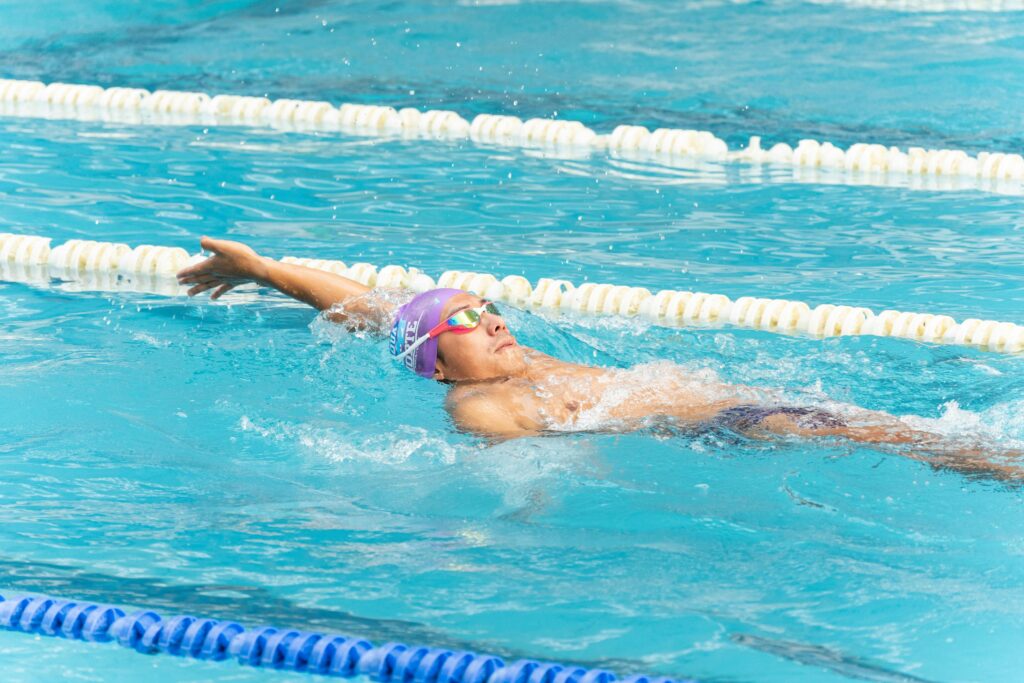
Swimming backstroke activates several upper body muscle groups that work together to create powerful propulsion through water. The unique position of swimming on your back creates distinct muscle engagement patterns that differ from other swimming strokes.
Latissimus Dorsi and Back Muscles
The latissimus dorsi muscles (lats) are the primary muscles used during the backstroke pull phase. Unlike other strokes where the pectorals initiate movement, in backstroke, the lats engage first to create the initial pull through the water.
The rhomboids work alongside the lats to stabilise the shoulder blades during the stroke cycle, ensuring proper arm positioning throughout the movement. This helps maintain efficient technique and prevents shoulder injuries.
The trapezius muscles play a crucial role in shoulder rotation and scapular movement. They work to elevate, retract and rotate the shoulder blades during the recovery phase of the backstroke.
The erector spinae group helps maintain proper body alignment and stabilises the spine while swimming on your back. Strong lower back muscles are essential for maintaining the ideal horizontal body position.
Deltoids and Shoulder Muscles
The deltoid muscles are heavily engaged throughout the backstroke motion. The posterior deltoids initiate the pull phase, while the anterior and lateral deltoids assist with the recovery portion of the stroke cycle.
The rotator cuff muscles, including the teres minor, are critical for shoulder stability during backstroke. These small but important muscles help control arm rotation and prevent shoulder injuries that can occur from repetitive overhead movements.
The serratus anterior assists with scapular movement and helps maintain proper shoulder positioning. This muscle is particularly active during the recovery phase as the arm moves overhead and re-enters the water.
Backstroke requires excellent shoulder mobility and strength. Regular backstroke training can improve shoulder range of motion and help develop balanced shoulder musculature.
Pectoral and Chest Muscles
Though less dominant than in other strokes, the pectoralis major (pecs) still contributes significantly to backstroke performance. These chest muscles engage during the latter part of the underwater pull phase.
The pectorals work in coordination with the lats to complete the propulsive phase of the stroke. As the arm moves from the side position toward the hip, the pectoral muscles contract to finish the pull through the water.
Developing balanced chest strength is important for backstroke swimmers to maintain proper stroke mechanics. Imbalances between chest and back muscles can lead to poor technique and potential injury.
The pecs also help stabilise the shoulder joint during the recovery phase when the arm moves overhead, working eccentrically to control the movement.
Arm and Forearm Muscles
The triceps are the primary arm muscles used during backstroke. They extend the elbow during the underwater pull phase, generating significant propulsive force. Strong triceps are essential for maintaining stroke power throughout a race.
The biceps work as antagonist muscles during backstroke. They control the arm during the recovery phase and help initiate the entry of the hand into the water above the head.
Forearm muscles, including wrist flexors and extensors, help maintain proper hand position and create an effective pulling surface. The correct hand orientation is crucial for maximising propulsion.
Swimmers often develop balanced arm musculature due to the alternating nature of the backstroke. This helps prevent muscular imbalances that could lead to injury or technique flaws.
Core Muscle Groups in Backstroke
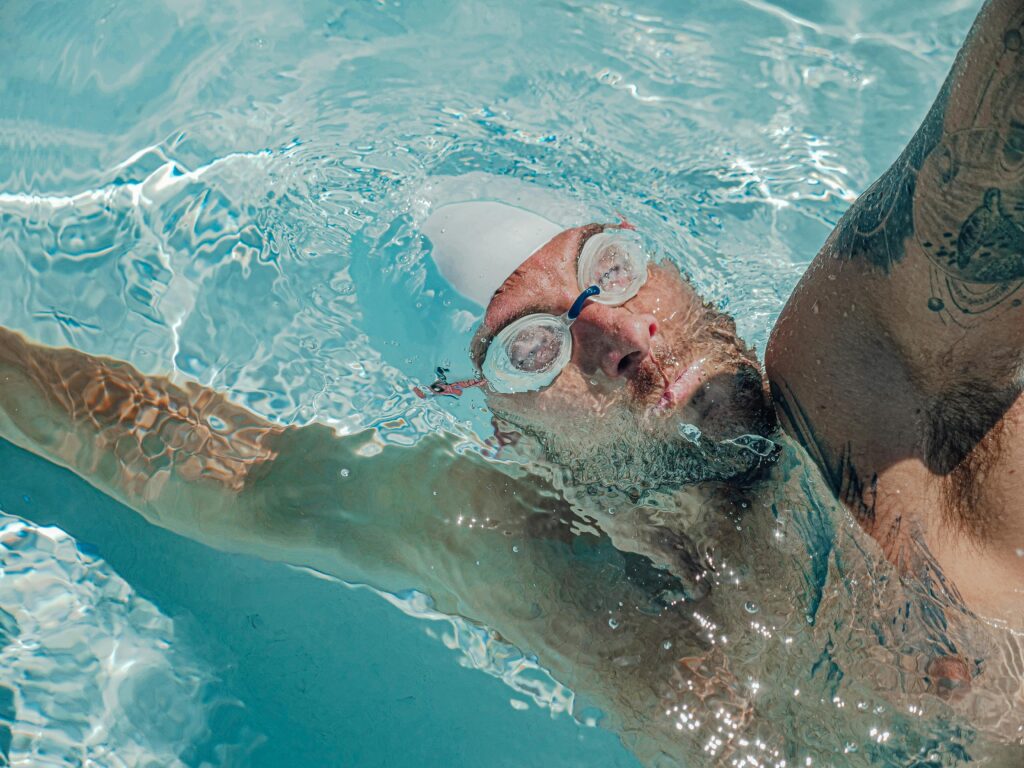
The backstroke heavily relies on a strong core to maintain proper body position and generate power through the water. Core muscles act as stabilisers and force transmitters, connecting the arm and leg movements while maintaining a streamlined position.
Abdominal Muscles and Core Stability
The abdominal muscles play a crucial role in backstroke swimming. The rectus abdominis (the “six-pack” muscle) contracts to maintain a flat body position at the water’s surface, preventing the hips from sinking.
The obliques (both internal and external) engage during the rotational movements that occur with each arm stroke. These muscles help swimmers maintain balance and stability whilst rotating from side to side.
During backstroke, core stability prevents excessive arching of the back, which would create drag. A tight core helps transmit power from the arms to the legs and vice versa, creating a more efficient stroke.
Core muscles activated during backstroke:
- Rectus abdominis
- Internal and external obliques
- Transverse abdominis
Core engagement must remain consistent throughout the stroke cycle to maintain proper body alignment and reduce resistance in the water.
Lower Back Muscle Engagement
The backstroke activates several back muscles, particularly in the lower region. The erector spinae group works constantly to stabilise the spine during the rolling motion of backstroke.
These muscles prevent excessive arching of the lower back, which would disrupt streamlining and increase drag. Strong lower back muscles also help maintain the horizontal body position essential for efficient backstroke technique.
Lower back muscle engagement works in coordination with the abdominal muscles to create a balanced core that supports the powerful movements of the arms and legs. This synergy between the anterior and posterior core is vital for optimal performance.
Proper lower back engagement also helps prevent injuries during backstroke training and competition. Many swimmers develop their back muscles’ range of motion through backstroke, enhancing overall mobility and strength in this area.
Lower Body Muscles Activated During Backstroke
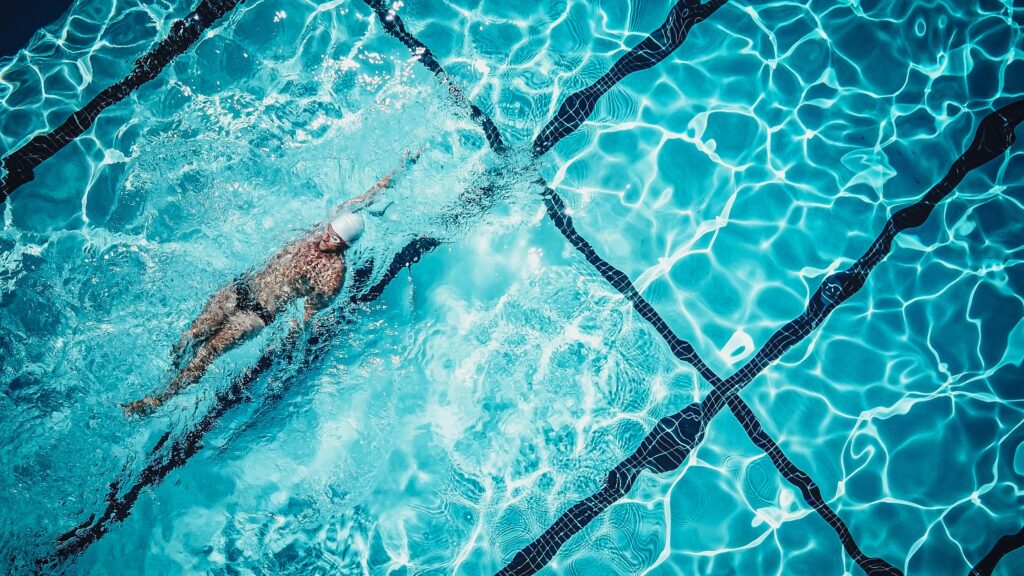
The backstroke engages several critical lower body muscle groups that provide propulsion and stability. These muscles work together to create the flutter kick that drives swimmers through the water while maintaining proper body position.
Legs and Thighs
The quadriceps muscles play a dominant role during backstroke. Located at the front of the thighs, these powerful muscles—particularly the rectus femoris—extend the knee during the downbeat of the flutter kick.
The hamstrings, situated at the back of the thighs, work in opposition to the quads. They flex the knee during the upward phase of the kick, preparing the leg for the next downward thrust.
When swimming backstroke, the quadriceps and hamstrings alternate between contraction and relaxation. This creates the continuous flutter kick motion essential for maintaining forward momentum.
Developing strong leg muscles is crucial for backstroke efficiency. Swimmers with powerful thighs can generate greater propulsive force with each kick, improving overall speed and reducing energy expenditure.
Gluteal Muscles and Hip Flexors
The gluteus maximus, your body’s largest muscle, works intensively during backstroke. These muscles extend the hip during the downward phase of the kick, generating significant power.
Hip flexors, including the iliopsoas group, activate during the upward phase of the flutter kick. They lift the leg back to the starting position, working against water resistance.
The coordination between glutes and hip flexors creates the rhythmic, alternating kick pattern characteristic of backstroke. This rhythm is essential for maintaining both speed and body position.
Strong gluteal muscles and flexible hip flexors contribute to:
- Better body position in the water
- More efficient kick mechanics
- Reduced strain on the lower back
- Greater overall propulsion
Calf Muscles and Ankles
The calf muscles, primarily the gastrocnemius and soleus, work to point the toes during the backstroke kick. This plantar flexion creates a more streamlined foot position, reducing drag.
The tibialis anterior, located at the front of the shin, performs the opposite action. It dorsiflexes the foot between kicks, preparing for the next pointed-toe position.
Ankle flexibility is particularly important in backstroke. Swimmers with greater range of motion can:
- Create a more effective kick
- Generate improved propulsion
- Maintain better technique throughout longer distances
A proper backstroke kick involves a slight inward rotation of the feet during the downbeat. This technique maximises the surface area pushing against the water, increasing the propulsive force generated with each kick.
Strengthening these lower leg muscles can significantly improve kick efficiency and overall backstroke performance.
Muscle Engagement Throughout the Backstroke Phases
The backstroke engages multiple muscle groups in a coordinated sequence to generate propulsion through water. Different muscles activate during specific phases of the stroke, with precise timing that creates efficient movement and forward momentum.
Pull and Propulsion Phase
The pull and propulsion phase begins when the hand enters the water above the head. This phase primarily engages the latissimus dorsi, the broad muscles of the upper back that provide most of the propulsive force. As the arm pulls through the water, the pectoralis major (chest muscles) also activates significantly.
During the catch phase, swimmers engage their deltoids and rotator cuff muscles to position the hand optimally. The triceps then activate to extend the elbow, increasing the power of the pull.
Lower body contribution comes from rhythmic kicking that engages the quadriceps, hamstrings and gluteal muscles. Core muscles—including the rectus abdominis and obliques—stabilise the body, maintaining proper horizontal position and transferring power between upper and lower body.
Recovery and Coordination Phase
The recovery phase begins as the arm exits the water near the hip. During this phase, the trapezius and rhomboid muscles in the upper back work to rotate and lift the arm. The deltoid muscles, particularly the anterior and middle portions, elevate the arm overhead.
Biceps brachii muscles flex the elbow during the early recovery, creating a more efficient movement pattern. The forearm muscles control hand position throughout the recovery.
Proper coordination requires alternating arm movements whilst maintaining continuous leg action. This synchronisation engages the core muscles continuously, with the serratus anterior and external obliques controlling trunk rotation.
During sprint efforts, swimmers increase their cadence by intensifying engagement of the trapezius and latissimus dorsi muscles, which produces a temporarily higher stroke rate and increased speed through the water.
Benefits of Backstroke for Muscle Development
Swimming backstroke offers exceptional muscle development benefits while being gentle on the joints. This stroke engages multiple muscle groups simultaneously, making it an efficient way to build strength and enhance flexibility.
Full-Body Exercise Advantages
The backstroke is truly a full-body exercise that works muscles from head to toe. Unlike land-based exercises, it distributes effort across the entire body, reducing the risk of overuse injuries.
Core muscles, including the abdominals and lower back, must stay engaged throughout the stroke to maintain proper body position. This continuous activation helps develop a stronger core.
The backstroke is particularly effective for developing the posterior chain muscles. These include the trapezius, rhomboids, and latissimus dorsi, which often get neglected in daily activities.
For those with joint concerns, backstroke provides cardiovascular benefits without the impact. The water supports body weight, making it an ideal exercise for those with mobility limitations.
Strength, Endurance, and Flexibility Gains
Regular backstroke swimming significantly improves muscle strength and endurance. The constant resistance of water creates a natural form of resistance training for all muscle groups involved.
Shoulder and back muscles gain exceptional range of motion and mobility through the rotational movements required. This increased flexibility helps improve posture and reduce risk of shoulder injuries.
Leg muscles develop balanced strength through the continuous kicking motion. Both the quadriceps and hamstrings work in coordination, promoting symmetrical development.
The backstroke also builds remarkable muscular endurance due to its rhythmic nature. Swimmers can maintain the stroke for extended periods, gradually increasing stamina in all major muscle groups.
Improving Muscle Engagement and Strength for Backstroke
Developing specific muscles for backstroke requires targeted training both in and out of the water. Proper muscle engagement improves power, speed and reduces injury risk during the demanding movements of backstroke swimming.
Dryland Exercises for Swimmers
Building backstroke-specific strength requires exercises that target the primary muscle groups used during this stroke. The following exercises are particularly effective:
Upper Body Focus:
- Lat pulldowns: 3 sets of 10-12 reps to strengthen the latissimus dorsi
- Reverse flies: 2-3 sets of 12-15 reps for posterior deltoids
- Tricep dips: 3 sets to failure for arm extension power
Core Stability Work:
- Supine back extensions to strengthen the erector spinae
- Swiss ball exercises that mimic the rotational movements in backstroke
- Plank variations (3 sets of 30-60 seconds) to build overall core stability
Resistance bands provide excellent simulation of the water resistance experienced during backstroke. Perform pull-throughs with bands attached at shoulder height to replicate the arm movement pattern while engaging the correct muscles.
Techniques for Enhanced Performance
Proper technique dramatically improves muscle engagement during backstroke. Swimmers should focus on these key elements:
Body Position:
- Maintain a high hip position to reduce drag
- Keep shoulders rolled back to engage lats properly
- Stabilise the core throughout the stroke cycle
Arm Movement Refinement:
- Enter the water with the pinky finger first (thumb last)
- Pull deep with a bent elbow during the underwater phase
- Accelerate through the finish of each pull
Using tempo trainers helps swimmers develop the neurological patterns needed for optimal muscle recruitment. Working with varied tempos (slower for technique, faster for power) trains different muscle fibre types.
Video analysis sessions can identify areas where muscle engagement is inefficient. Common issues include dropping elbows during the underwater pull or excessive knee bend during the kick.
Importance of Recovery and Injury Prevention
The repetitive nature of backstroke places significant demands on the shoulder and back muscles, making recovery essential for performance and injury prevention.
Recovery Strategies:
- Active recovery swims using different strokes to avoid overuse
- Foam rolling the lats, traps and rhomboids for 2-3 minutes daily
- Contrast therapy (alternating hot and cold) for major muscle groups
Preventative Exercises:
- Rotator cuff strengthening with light weights (3 sets of 15-20 reps)
- Scapular stabilisation exercises like Y-T-L raises
- Thoracic spine mobility drills to maintain range of motion
Tracking training load helps prevent overtraining syndromes that lead to injury. A balanced strength programme should address any muscle imbalances between the chest and back that commonly develop in backstroke swimmers.
Maintaining proper nutrition and hydration supports muscle recovery and growth, particularly consuming protein within 30 minutes after training sessions.
The Role of Breathing and Core Stability in Backstroke
Proper breathing technique is essential for effective backstroke swimming. Unlike other strokes, backstroke breathing allows swimmers to keep their face above water, making inhalation and exhalation more straightforward.
The rhythm of breathing should match the stroke pattern. Most swimmers find that establishing a consistent breathing pattern helps maintain proper form and prevents unnecessary tension in the neck and shoulders.
Core stability plays a crucial role in backstroke efficiency. The core muscles—including the abdominals, obliques and lower back—act as the foundation for all movement in the water.
When the core is properly engaged, it helps maintain the ideal horizontal body position that is vital for effective backstroke technique. A strong core prevents the hips from dropping, which would otherwise create drag.
The connection between breathing and core stability cannot be overlooked. Deep, rhythmic breathing helps activate the diaphragm, which contributes to core engagement and overall stability in the water.
The rotation of shoulders, trunk and hips relies on core strength to remain controlled. This rotation is essential for placing the arms and legs in optimal positions for propulsion.
Swimmers with weak core muscles often struggle with maintaining proper body alignment during backstroke, leading to inefficient movement and quicker fatigue.
Practising specific core-strengthening exercises on land can significantly improve backstroke performance in the water. Planks, rotational exercises and stability work are particularly beneficial.

